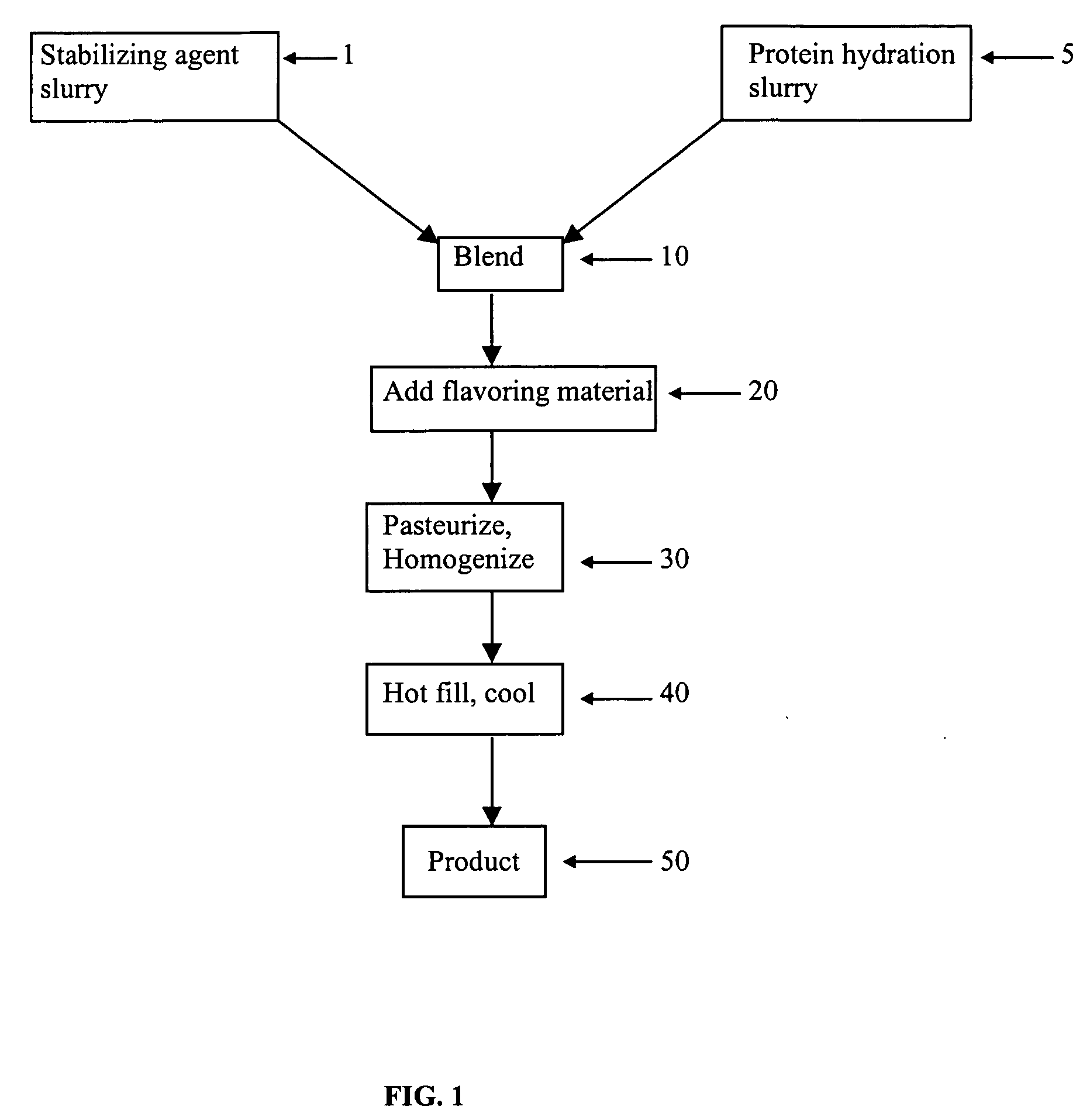Acid beverage composition and process for making same utilizing an aqueous protein component
a technology of acid beverage and protein, which is applied in the field of acid beverage preparation of protein based acid beverage, can solve the problems of protein tending to settle out, relative insolubility of proteins in acidic environment, and undesirable quality
- Summary
- Abstract
- Description
- Claims
- Application Information
AI Technical Summary
Benefits of technology
Problems solved by technology
Method used
Image
Examples
example 1
[0086] To an extraction tank is added 100 pounds of defatted soybean flakes and 1000 pounds water. The contents are heated to 90° F. and sufficient calcium hydroxide is added to adjust the pH to 9.7. This provides a weight ratio of water to flakes of 10:1. The flakes are separated from the extract and reextracted with 600 lbs. of water having a pH of 9.7 and a temperature of 90° F. This second extraction step provides a weight ratio of water to flakes of 6:1. The flakes are removed by centrifugation, and the first and second extracts are combined and adjusted to a pH of 4.5 with either hydrochloric acid or phosphoric acid, which forms a precipitated protein curd and a soluble aqueous whey. The acid precipitated water insoluble curd is separated from the aqueous whey by centrifuging and washing in a CH-14 centrifuge at a speed of 4,000 rpm and a Sharples P3400 centrifuge at a speed of 3,000 rpm. Protein curds are re-suspended in water at a 10-12% solid concentration and the pH is adj...
example 2
[0087] To an extraction tank is added 100 pounds of defatted soybean flakes and 600 pounds water. The contents are heated to 90° F. and sufficient calcium hydroxide is added to adjust the pH to 9.7. This provides a weight ratio of water to flakes of 6:1. The flakes are separated from the extract and reextracted with 400 lbs. of water having a pH of 9.7 and a temperature of 90° F. This second extraction step provides a weight ratio of water to flakes of 4:1. The flakes are removed by centrifugation, and the first and second extracts are combined and adjusted to a pH of 4.5 with phosphoric acid, which forms a precipitated protein curd and a soluble aqueous whey. The acid precipitated water insoluble curd is separated from the aqueous whey by centrifuging and washing in a CH-14 centrifuge at a speed of 4,000 rpm and a Sharples P3400 centrifuge at a speed of 3,000 rpm. Protein curds are re-suspended in water at a 10-12% solid concentration to give a diluted curd. Added to the diluted cu...
example 3
[0088] The procedure of Example 1 is repeated with the following exception. A 3.4% total solids aqueous slurry of freshly prepared calcium phosphate is added after the first addition of an aqueous solution of a mixture of sodium hydroxide and potassium hydroxide. The product obtained is a calcium fortified aqueous protein material.
PUM
 Login to View More
Login to View More Abstract
Description
Claims
Application Information
 Login to View More
Login to View More - R&D
- Intellectual Property
- Life Sciences
- Materials
- Tech Scout
- Unparalleled Data Quality
- Higher Quality Content
- 60% Fewer Hallucinations
Browse by: Latest US Patents, China's latest patents, Technical Efficacy Thesaurus, Application Domain, Technology Topic, Popular Technical Reports.
© 2025 PatSnap. All rights reserved.Legal|Privacy policy|Modern Slavery Act Transparency Statement|Sitemap|About US| Contact US: help@patsnap.com



